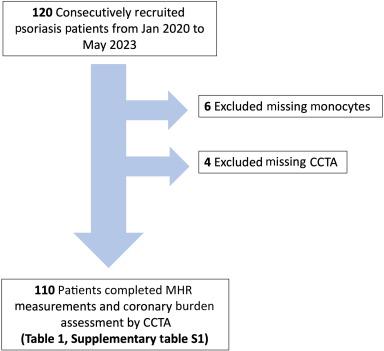当前位置:
X-MOL 学术
›
J. Invest. Dermatol.
›
论文详情
Our official English website, www.x-mol.net, welcomes your feedback! (Note: you will need to create a separate account there.)
Monocyte-to-High-Density Lipoprotein Ratio Is Associated with Systemic Inflammation, Insulin Resistance, and Coronary Subclinical Atherosclerosis in Psoriasis: Results from 2 Observational Cohorts
Journal of Investigative Dermatology ( IF 6.5 ) Pub Date : 2024-03-07 , DOI: 10.1016/j.jid.2024.02.015 Emilio Berna-Rico , Carlota Abbad-Jaime de Aragon , Asuncion Ballester-Martinez , Javier Perez-Bootello , Jorge Solis , Leticia Fernandez-Friera , Mar Llamas-Velasco , Maria Castellanos-Gonzalez , Maria G. Barderas , Carlos Azcarraga-Llobet , Emilio Garcia-Mouronte , Belen de Nicolas-Ruanes , Jorge Naharro-Rodriguez , Pedro Jaen-Olasolo , Joel M. Gelfand , Nehal N. Mehta , Alvaro Gonzalez-Cantero
Journal of Investigative Dermatology ( IF 6.5 ) Pub Date : 2024-03-07 , DOI: 10.1016/j.jid.2024.02.015 Emilio Berna-Rico , Carlota Abbad-Jaime de Aragon , Asuncion Ballester-Martinez , Javier Perez-Bootello , Jorge Solis , Leticia Fernandez-Friera , Mar Llamas-Velasco , Maria Castellanos-Gonzalez , Maria G. Barderas , Carlos Azcarraga-Llobet , Emilio Garcia-Mouronte , Belen de Nicolas-Ruanes , Jorge Naharro-Rodriguez , Pedro Jaen-Olasolo , Joel M. Gelfand , Nehal N. Mehta , Alvaro Gonzalez-Cantero

|
Systemic inflammation or insulin resistance drive atherosclerosis. However, they are difficult to capture for assessing cardiovascular risk in clinical settings. The monocyte-to-high-density lipoprotein ratio (MHR) is an accessible biomarker that integrates inflammatory and metabolic information and has been associated with poorer cardiovascular outcomes. Our aim was to evaluate the association of MHR with the presence of subclinical atherosclerosis in patients with psoriasis. The study involved a European and an American cohort including 405 patients with the disease. Subclinical atherosclerosis was assessed by coronary computed tomography angiography. First, MHR correlated with insulin resistance through homeostatic model assessment for insulin resistance, with high-sensitivity CRP and with F-fluorodeoxyglucose uptake in spleen, liver, and bone marrow by positron emission tomography/computed tomography. MHR was associated with both the presence of coronary plaques >50% of the artery lumen and noncalcified coronary burden, beyond traditional cardiovascular risk factors ( < .05). In a noncalcified coronary burden prediction model accounting for cardiovascular risk factors, statins, and biologic treatment, MHR added value (area under the curve base model = 0.72 vs area under the curve base model plus MHR = 0.76, = .04) within the American cohort. These results suggests that MHR may detect patients with psoriasis who have subclinical burden of cardiovascular disease and warrant more aggressive measures to reduce lifetime adverse cardiovascular outcomes.
中文翻译:

单核细胞与高密度脂蛋白的比率与银屑病的全身炎症、胰岛素抵抗和冠状动脉亚临床动脉粥样硬化有关:2 个观察组的结果
全身炎症或胰岛素抵抗会导致动脉粥样硬化。然而,它们很难用于评估临床环境中的心血管风险。单核细胞与高密度脂蛋白比率 (MHR) 是一种可获取的生物标志物,整合了炎症和代谢信息,并与较差的心血管结局相关。我们的目的是评估 MHR 与银屑病患者亚临床动脉粥样硬化的关系。该研究涉及欧洲和美国的队列,其中包括 405 名患有该疾病的患者。通过冠状动脉计算机断层扫描血管造影评估亚临床动脉粥样硬化。首先,通过正电子发射断层扫描/计算机断层扫描,通过胰岛素抵抗的稳态模型评估,MHR与胰岛素抵抗相关,高灵敏度CRP以及脾脏、肝脏和骨髓中的F-氟脱氧葡萄糖摄取。 MHR 与冠状动脉斑块 > 50% 的动脉腔和非钙化冠状动脉负荷相关,超出了传统的心血管危险因素 (< .05)。在考虑心血管危险因素、他汀类药物和生物治疗的非钙化冠状动脉负荷预测模型中,美国境内的 MHR 附加值(曲线基础模型下面积 = 0.72 对比曲线基础模型下面积加 MHR = 0.76,= .04)队列。这些结果表明,MHR 可以检测出患有亚临床心血管疾病负担的银屑病患者,并需要采取更积极的措施来减少终生不良心血管结局。
更新日期:2024-03-07
中文翻译:

单核细胞与高密度脂蛋白的比率与银屑病的全身炎症、胰岛素抵抗和冠状动脉亚临床动脉粥样硬化有关:2 个观察组的结果
全身炎症或胰岛素抵抗会导致动脉粥样硬化。然而,它们很难用于评估临床环境中的心血管风险。单核细胞与高密度脂蛋白比率 (MHR) 是一种可获取的生物标志物,整合了炎症和代谢信息,并与较差的心血管结局相关。我们的目的是评估 MHR 与银屑病患者亚临床动脉粥样硬化的关系。该研究涉及欧洲和美国的队列,其中包括 405 名患有该疾病的患者。通过冠状动脉计算机断层扫描血管造影评估亚临床动脉粥样硬化。首先,通过正电子发射断层扫描/计算机断层扫描,通过胰岛素抵抗的稳态模型评估,MHR与胰岛素抵抗相关,高灵敏度CRP以及脾脏、肝脏和骨髓中的F-氟脱氧葡萄糖摄取。 MHR 与冠状动脉斑块 > 50% 的动脉腔和非钙化冠状动脉负荷相关,超出了传统的心血管危险因素 (< .05)。在考虑心血管危险因素、他汀类药物和生物治疗的非钙化冠状动脉负荷预测模型中,美国境内的 MHR 附加值(曲线基础模型下面积 = 0.72 对比曲线基础模型下面积加 MHR = 0.76,= .04)队列。这些结果表明,MHR 可以检测出患有亚临床心血管疾病负担的银屑病患者,并需要采取更积极的措施来减少终生不良心血管结局。



























 京公网安备 11010802027423号
京公网安备 11010802027423号